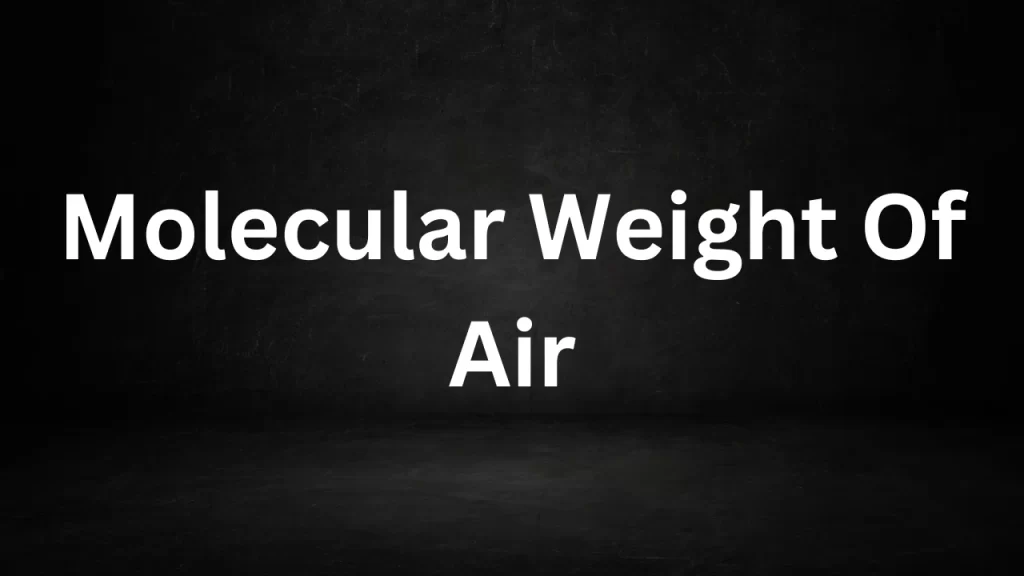Tag: weight of carbon monoxide
Molecular Weight Of Air
Molecular Weight Of Air: Air, the invisible mixture of gases that surrounds our planet, plays a vital role in sustaining life. While it may seem weightless, it does indeed have a molecular weight. In this article, we will explore the concept of the mole weight of air, its composition, and its significance in various scientific and practical applications.

Molecular Weight Of Air
Composition of Air:
The predominant components of air are the two major gases: nitrogen (N2) and oxygen (O2). These two gases make up the majority of the Earth’s atmosphere, accounting for approximately 99% of the total volume. Other gases, such as carbon dioxide (CO2), argon (Ar), neon (Ne), helium (He), and traces of other elements and compounds, make up the remaining 1%.
Calculating the Molecular Weight of Air:
To calculate the mole weight of air, we must consider the molecular weights of its constituent gases and their relative abundances. Here are the key steps to determine the mole weight of air:
- Identify the Constituent Gases: As mentioned earlier, nitrogen (N2) and oxygen (O2) are the two most abundant gases in the atmosphere. Their molecular weights are approximately 28 g/mol (for N2) and 32 g/mol (for O2).
- Determine the Relative Abundances: The Earth’s atmosphere consists of approximately 78% nitrogen (N2) and 21% oxygen (O2). The remaining gases make up the remaining 1%.
- Calculate the Weighted Average: To find air’s molecular weight, calculate a weighted average using the molecular weights and relative gas abundances.
Using this formula:
mole Weight of Air (g/mol) = (Abundance of N2 × mole Weight of N2) + (Abundance of O2 × mole Weight of O2) + …
mole Weight of Air (g/mol) = (0.78 × 28 g/mol) + (0.21 × 32 g/mol) + …
The calculated mole weight of air is approximately 28.97 g/mol.
Significance of Molecular Weight of Air:
- Avogadro’s Law: The mole weight of air is crucial for understanding Avogadro’s law, which states that equal volumes of gases, at the same temperature and pressure, contain an equal number of molecules. This principle is essential in the study of gases.
- Gas Laws: Knowledge of the mole weight of air is essential in various gas laws, such as the ideal gas law (PV = nRT), where it helps in calculating the properties of gases under different conditions.
- Atmospheric Science: Understanding the mole weight of air is vital in atmospheric science, including weather forecasting and the study of air pollutants.
- Aeronautics and Aviation: In aviation, engineers and pilots use air’s molecular weight to evaluate aircraft performance, including lift and thrust.
Conclusion:
The mole weight of air, approximately 28.97 g/mol, provides a foundational understanding of the Earth’s atmosphere. It is a critical factor in various scientific fields, including chemistry, physics, atmospheric science, and engineering. Comprehending air’s composition and properties aids in grasping natural phenomena and advancing technologies dependent on gas behavior in our environment.
Read More
- Molecular Weight Of K2Cr2O7
- Molecular Weight Of Phosphorus
- Molecular Weight Of SO2
- Molecular Weight of Na2CO3
- Molecular Mass Of Sodium
Frequently Asked Questions (FAQs) Molecular Weight Of Air
Q1: What is the molecular weight of air?
A1: The mole weight of air is approximately 28.97 grams per mole (g/mol). This value is calculated based on the molecular weights and relative abundances of its constituent gases, primarily nitrogen (N2) and oxygen (O2).
Q2: Why is it important to know the molecular weight of air?
A2: Understanding the mole weight of air is important in various scientific fields and practical applications. It helps in gas law calculations, atmospheric science, aeronautics, and aviation, among others. It also serves as a fundamental concept in the study of gases.
Q3: How is the molecular weight of air calculated?
A3: The mole weight of air is calculated by considering the mole weights of its constituent gases (e.g., nitrogen and oxygen) and their relative abundances in the atmosphere. It involves a weighted average calculation based on these factors.
Q4: Does the molecular weight of air change with altitude or location?
A4: The mole weight of air remains relatively constant at different altitudes and locations on Earth. However, variations in the composition of air, such as changes in the concentration of water vapor or pollutants, can cause minor fluctuations in the molecular weight of air.
Q5: How is the molecular weight of air used in aviation and aeronautics?
A5: In aviation and aeronautics, the mole weight of air is used to determine aircraft performance, including lift, thrust, and engine efficiency. It plays a crucial role in calculations related to aircraft design and operation.